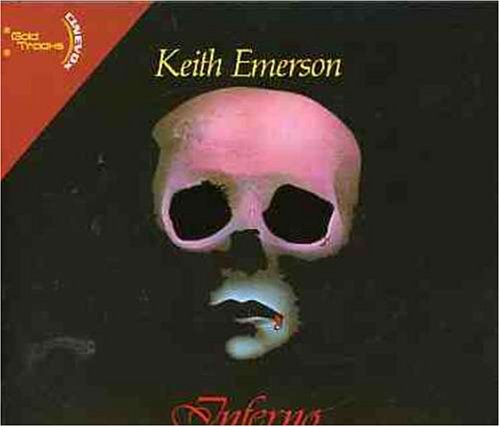
Keith Emerson – the keyboard genius and composer – has died. According to Rolling Stone, the 71-year-old musician was found at his home in Santa Monica, with a single gunshot wound in his head – an apparent suicide (though that has not been confirmed yet). Emerson was known mostly for his virtuoso keyboard work in the 1970s prog-rock band Emerson, Lake, and Palmer, but he also provided soundtrack music for such horror films as Dario Argento’s INFERNO, Lucio Fulci’s MURDER ROCK, Michele Soavi’s THE CHURCH, and Godzilla’s 2004 swansong, GODZILLA: FINAL WARS.
Emerson was a flashy musician, who combined virtuoso technique worth of a concert pianist with outrageous stage antics (such as thumping his Hammond organ up and down to distort the sound, and using alligator clamps on the keyboard to create droning notes over which he could solo). Besides organ and piano, he was an early user of the Moog synthesizer, a monophonic instrument that could produce novel, electronic sounds, which Emerson used to create amazing solos and sonic landscapes, many with fantasy, science fiction, or mythological overtones, such as “The Three Fates” and “Tarkus,” an epic suite whose cover art suggested an epic battle between a manticore and a biomechanical armadillo-tank. His music combined rock and pop with classical and jazz influences. He frequently performed rock arrangements of classical pieces such as Holst’s Mars, Bringer of War (on the Emerson, Lake, and Powell album from 1986) and Mussorgsky’s Pictures at an Exhibition, a staple of Emerson, Lake, and Palmer’s live shows (including the throbbing and creepy “Hut of Baba Yaga,” inspired by a painting of a witch-like character from Slavic folklore).

Emerson, Lake and Palmer’s 1973 album Brain Salad Surger featured cover artwork by H.R. Giger, and climaxed with Karn Evil 9 – 3rd Impression, which featured an early use of a sequencer (a device to pre-program notes which can be played back at any speed), with lyrics suggesting a futuristic battle between humanity and artificial intelligence.
Emerson’s work on INFERNO – his debut as a soundtrack composer – features a quieter, moody approach, with melancholy piano chords over strings, but there are a some faster-paced cues with pulsing rhythms and/or ominous electronic sounds. The soundtrack album represents some of his finest, most subtle work. It is also remarkable for representing one of the few times that director Dario Argento used a complete score intact in one of his films, instead of cutting and pasting together bits and pieces: the music on the album and in the movie coincide almost identically (with one or two minor deviations).
Emerson’s later soundtrack work was not up to par with INFERNO. NIGHTHAWKS was adequate. MURDER ROCK has one or two interesting cues. His main theme for THE CHURCH was effective, but his contribution to that film was limited to a few cues, mixed in with contributions from Phillip Glass, Simon Boswell, and Fabio Pignatelli of Goblin.

GODZILLA: FINAL WARS was another patch-job, stitched together from Emerson’s contributions, along with music by Daisuke Yano and Nobuhiko Morino. Fortunately, Emerson’s distinctive contribution shines through, particularly his glistening fanfare for the main title theme, which features Emeron’s trademark keyboard sound, emulating brassy orchestra.
Emerson, Lake, and Palmer’s back catalog remains easily available. Emerson’s soundtrack albums may be out of print or hard to find, but the tracks were assembled into the album Keith Emerson at the Movies, which is available on CD through Amazon and via streaming through Spotify.
Tag: Keith Emerson
Inferno by Keith Emerson – Soundtrack Review
 Although often compared unfavorably to Goblin’s music for SUSPIRIA, keyboardist Keith Emerson’s score for the sequel, INFERNO, is every bit as in tune with the film, perfectly matching the mood and action. Unlike Goblin’s heavy rhythms, shrieking vocals, and shrill synthesizers of the previous film, Emerson employs a much more subtle approach, weaving a score out of quiet piano motifs supported by orchestral arrangements, only occasionally reaching into his electronic bag of tricks for a more outre effect. The result comes closer to a conventional piece of film scoring, underlining the on-screen action without drawing as much attention to itself. Continue reading “Inferno by Keith Emerson – Soundtrack Review”
Although often compared unfavorably to Goblin’s music for SUSPIRIA, keyboardist Keith Emerson’s score for the sequel, INFERNO, is every bit as in tune with the film, perfectly matching the mood and action. Unlike Goblin’s heavy rhythms, shrieking vocals, and shrill synthesizers of the previous film, Emerson employs a much more subtle approach, weaving a score out of quiet piano motifs supported by orchestral arrangements, only occasionally reaching into his electronic bag of tricks for a more outre effect. The result comes closer to a conventional piece of film scoring, underlining the on-screen action without drawing as much attention to itself. Continue reading “Inferno by Keith Emerson – Soundtrack Review”